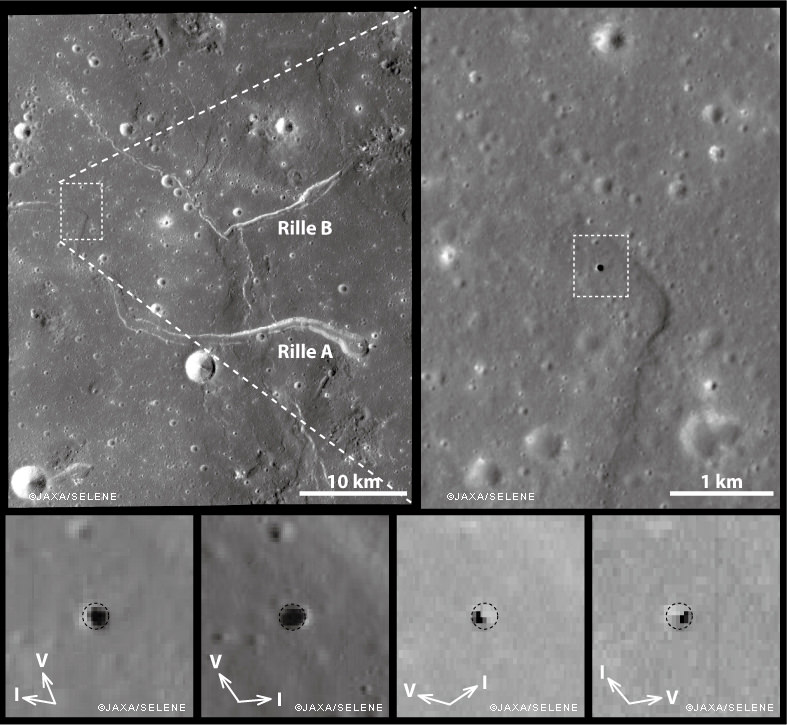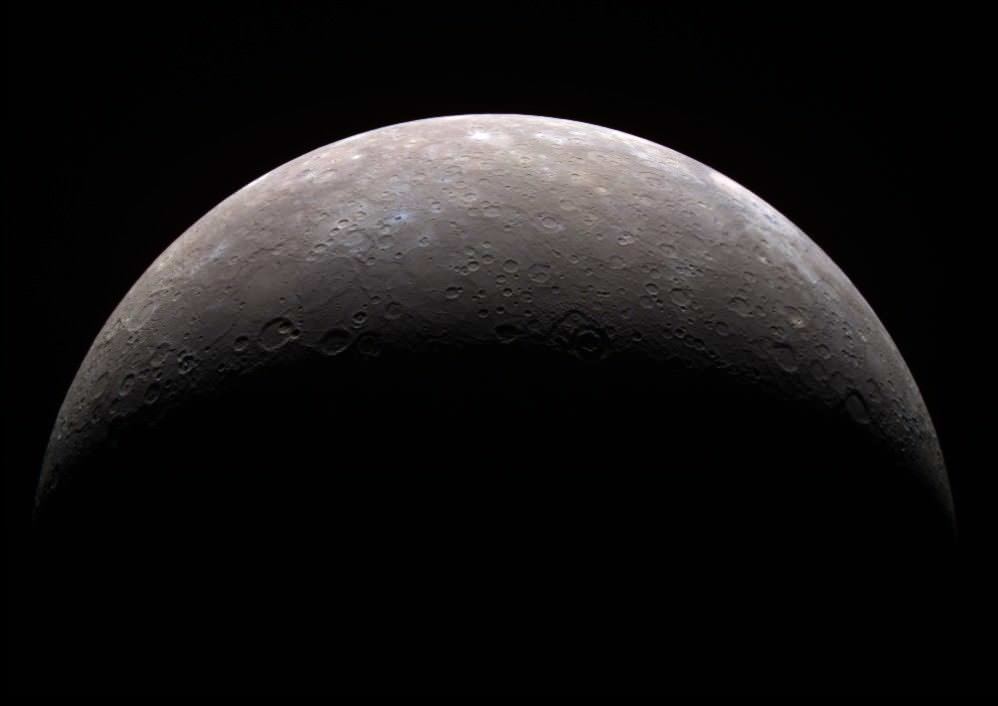Could lava tubes on the Moon and Mars play a role in establishing a human presence on those worlds? Possibly, according to a team of researchers. Their new study shows that lunar and Martian lava tubes might be enormous, and easily large enough to accommodate a base.
Continue reading “Lava Tubes on the Moon and Mars are Really, Really Big. Big Enough to Fit an Entire Planetary Base”Why Lava Tubes Should be Our Top Exploration Priority on Other Worlds

When magma comes out of the Earth onto the surface, it flows as lava. Those lava flows are fascinating to watch, and they leave behind some unique landforms and rocks. But a lot of what’s fascinating about these flows can be hidden underground, as lava tubes.
These lava tubes are turning out to be a very desirable target for exploration on other worlds, just as they are here on Earth.
Continue reading “Why Lava Tubes Should be Our Top Exploration Priority on Other Worlds”Carnival of Space #558
Welcome to the 558th Carnival of Space! The Carnival is a community of space science and astronomy writers and bloggers, who submit their best work each week for your benefit. We have a fantastic roundup today, so now, on to this week’s stories!
Continue reading “Carnival of Space #558”
Living Underground on Other Worlds. Exploring Lava Tubes

The Moon and Mars will probably be the first places in the Solar System that humanity will try to live after leaving the safety and security of Earth. But those worlds are still incredibly harsh environments, with no protection from radiation, little to no atmosphere, and extreme temperatures.
Living on those worlds is going to be hard, it’s going to be dangerous. Fortunately, there are a few pockets on those worlds that’ll make it a tiny little bit easier to get a foothold in the Solar System: lava tubes.
I’m going to show you some really cool photographs now. First, let’s start with images of the Moon taken by NASA’s Lunar Reconnaissance Orbiter.
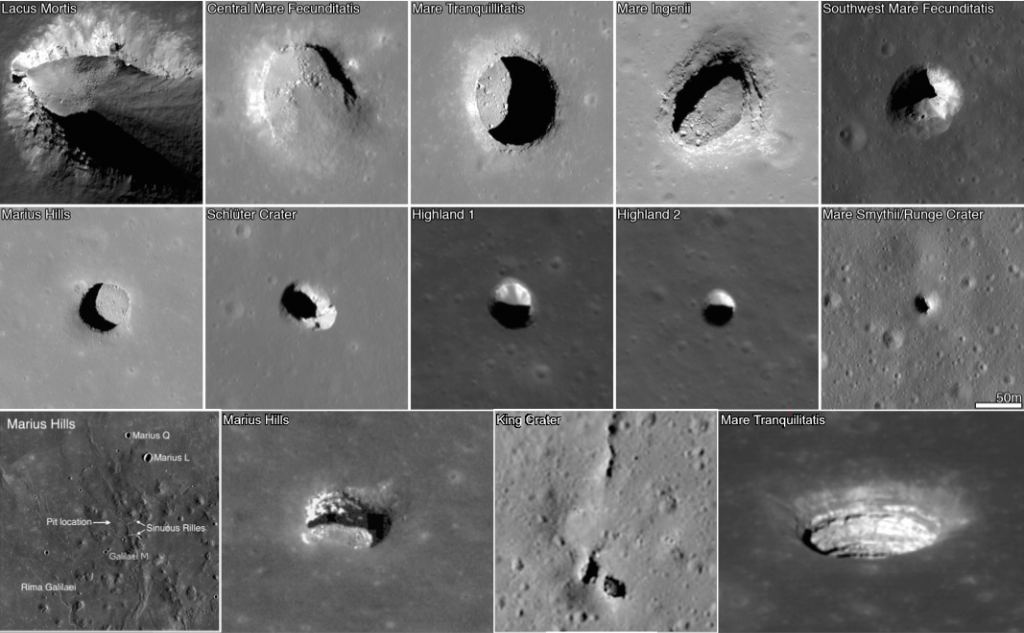
Those dark blobs in the photo are actually open skylights, the collapsed roofs of lava tubes on the Moon. They just look like dark areas because you can’t see the bottom. How cool is that?
And now, here are similar features on the surface of Mars. Here are several examples of cave skylights across the Red Planet.
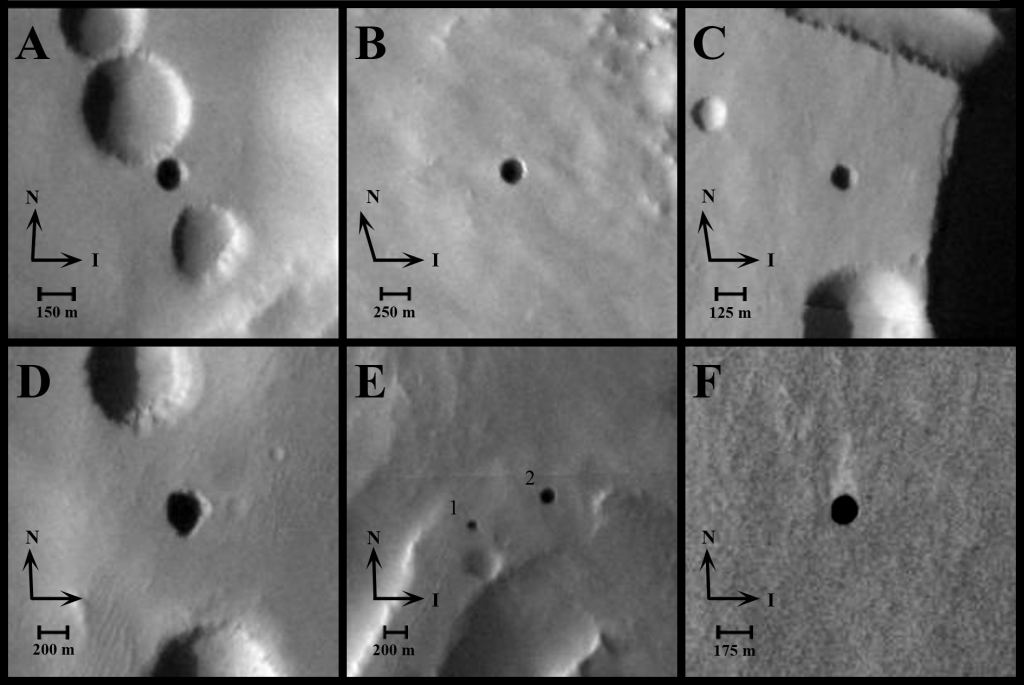
And I want to show you a really special one. Check out this photo, where you can see the cave opening, how the Martian sand is flowing down into the skylight. You can even see it piling up on the cave floor. There’s no question, this is a cavern on Mars with opening to the surface.
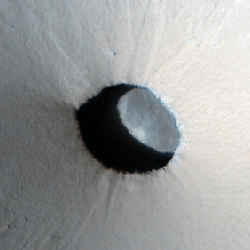
Want to live on the Moon or Mars? You’re looking at your future home.
Lava tubes are a common here on Earth, and you can find them wherever there’s been volcanic activity. During an eruption, lava gets flowing downhill through a channel. The surface cools and crusts over, but the lava keeps on flowing, like an underground river of molten rock.
In the right conditions, the lava can keep flowing, and empty out the channel completely, leaving behind a natural tunnel that can be dozens of kilometers long. The tubes can be wide, from a single meter to up to 15 meters wide. Definitely big enough to live inside.
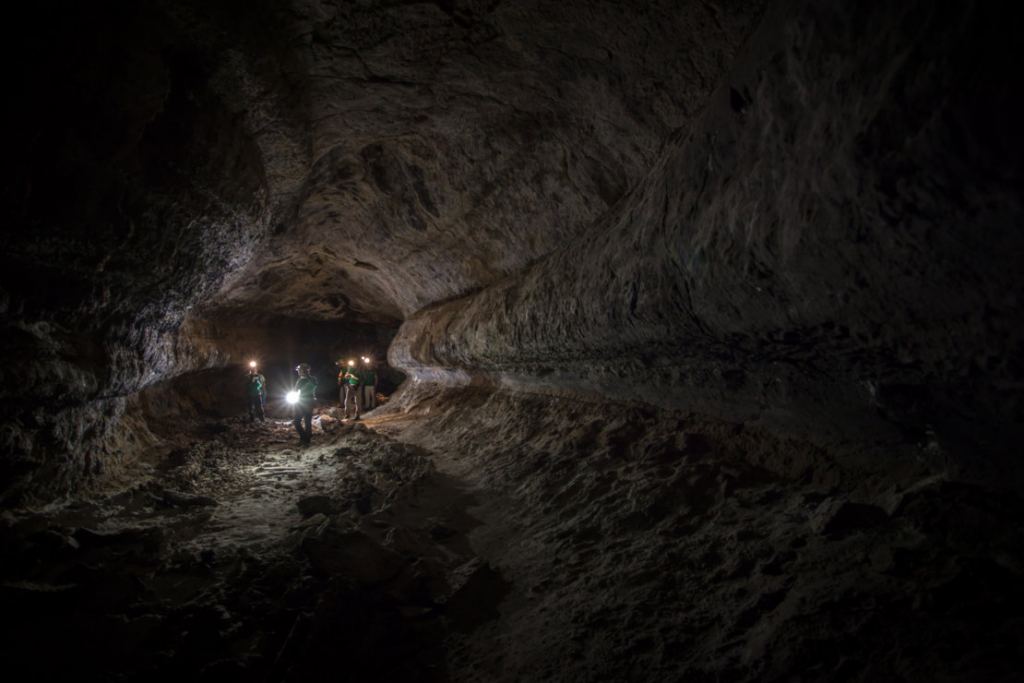
Both the Moon and Mars had periods of volcanism. The biggest volcano in the Solar System, Olympus Mons on Mars, is an enormous shield volcano with endless lava fields surrounding it.
The SETI Institute recently announced that they had identified a series of small pits in a crater near the Moon’s northern pole. They found them by analyzing images taken by NASA’s Lunar Reconnaissance Orbiter.
They look like skylights, and match similar features on Mars, where there is no crater rim, and just a shadowed dark feature. Further evidence is that they lie along lunar sinuous rilles, those ancient lava rivers with collapses features in a row.
At this point, there have been about 200 of these features discovered on the Moon so far, and more discovered on Mars too.
In addition to the skylights discovered by spacecraft, planetary scientists have uncovered vast pit chains on Mars, which could be collapsed lava tubes. With the amount of volcanism that occured on Mars over billions of years, there should be many features worth exploring.
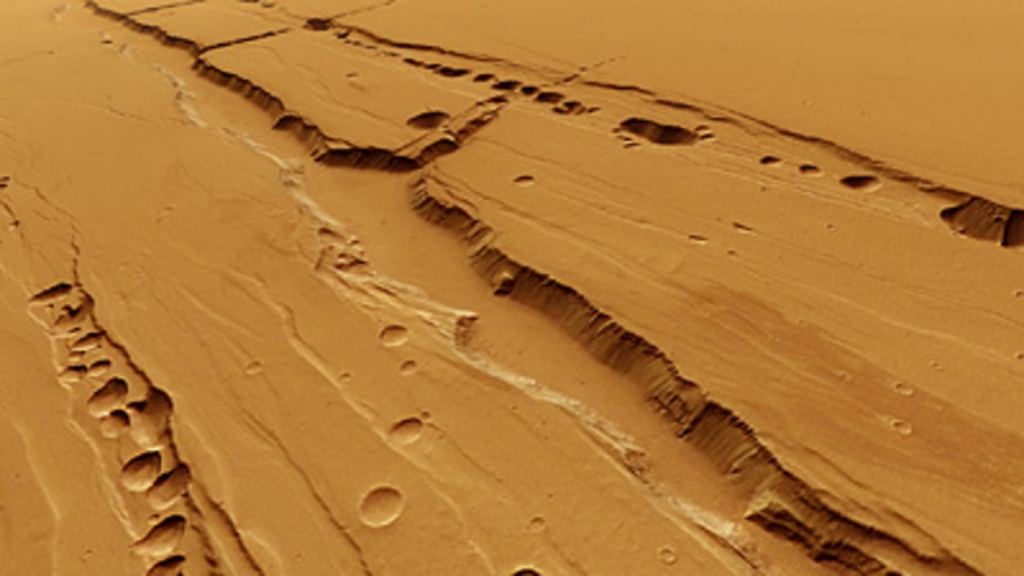
Because of the lower gravity on the Moon and Mars, lava tubes should be much more extreme. On Mars, there could be lava tubes that measure hundreds of meters across, and hundreds of kilometers long. On the Moon, lava tubes could be kilometers across. Big enough to hide a city inside.
Future Moon and Mars colonists will already be facing a life underground, to hide from the surface radiation, micrometeorite bombardment, extreme temperatures and to create a usable atmosphere. These natural tunnels will save them the hard work of needing to dig the tunnel.
The natural roofs on these caverns are thought to be 10 meters or more thick, with one site estimated to have a roof that’s 45-90 meters thick. This would be more than enough to protect against solar radiation and galactic cosmic radiation.
While the surface of the Moon varies in temperature from -180 C to +100 C, the interior of a lava tube would remain a constant chilly -20 C. This would be easy enough to keep warmed up, once it was sealed off and pressurized with a breathable atmosphere.
As we’ve mentioned time and time again, the lunar dust on the Moon is dangerous stuff, irritating eyes, nasal passages and lungs. Lunar colonists would want to minimize their exposure to it at all costs. By sealing off the interior of the lava tube, they could prevent further dust from getting in. In fact, the dust is also electrically charged, and could be a hazard to electronics.
In terms of resources, the Moon has plenty. There’s aluminum everywhere in the regolith, as well as iron and titanium. But the most valuable one for humans, water, could be down there too. In the eternally shadowed craters, there could be large deposits of water collected down below that colonists could harvest.
There’s another advantage, the lava tubes on Mars could be the best places to search for life on the Red Planet. The natural protection would also keep Martian bacteria less exposed to the harsh conditions of the surface.
Future explorers could be protected inside the lava tubes at the same time that they’re in the ideal place to search for life on Mars. That’s convenient.
Of course NASA and the European Space Agency have considered human and robotic missions that could travel to the Moon or Mars and explore the interiors of lava tubes.
In 2011, a group of researchers proposed a mission design for a combined lander-rover that would map out a skylight on the Moon in incredible detail. It’s known as the Marius Hills Hole, and measures about 65 meters across.
First, the lander would descend down to the surface of the Moon near the hole, using a pulsed laser called LIDAR to map out a 50-meter region around the landing site, looking for hazards.
The spacecraft would then choose a landing site and deploy a rover that would scan the region around the skylight in extreme detail, peeking down into the lava tube when the light is right.
Following that, would come the missions to actually explore down in the tunnels. Remember how big they are, potentially hundreds of meters and even kilometers across.
You can imagine various robotic rovers and landers, but one of my favorite ideas is a snake robot developed by SINTEF in Norway. The robot uses hydraulics to move segments of its body, allowing it to move like a real snake. It could climb stairs, navigate up and down slopes, go around corners, and be able to handle the unpredictable terrain of the floor of a lavatube.
After the robots come the humans. The tricky part is getting from the surface down to the tunnel floor. Mission planners have proposed traditional rappelling and even astronauts with jetpacks who would lower themselves down into the tunnel to explore around.
The first astronauts would descend down to the floor of the lava tube bringing quadruped pack mule robots that would be able to navigate the rough terrain of the tunnel floor. Once inside, they’d set up a communications link at the crater opening, and then deploy a pressurized tent as a temporary habitat.
The astronauts would be free to travel several kilometers into the lava tube, mapping the interior, and taking samples. They could set up their tent at different points, allowing a much deeper exploration.
Of course, then hostile cave aliens would pick them off one by one, and the only way we’d know about the mission is from a series of found footage and computer logs. But I digress.
The European Space Agency has been developing tools to measure the interior of caves here on Earth, to develop the technology that could be used to explore other worlds. You’re looking at a 3D image of the interior of a cave network in Spain.
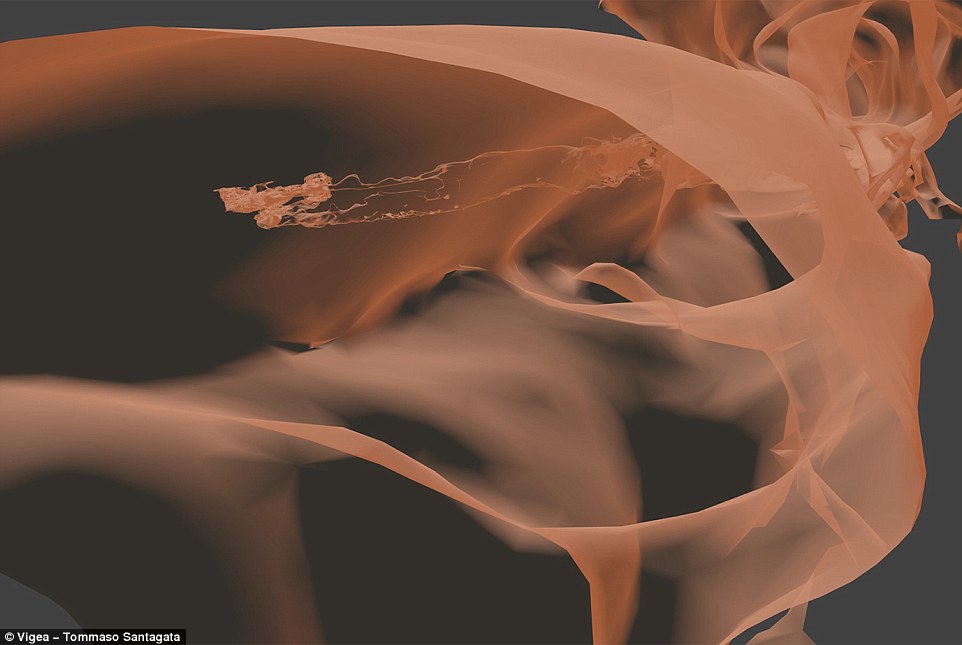
A team of researchers, including a European astronaut, used backpack-based cameras and LIDAR instruments to map out the cave to a resolution of just a few centimeters. They also tested out handheld tools to examine the cave walls, doing the same kinds of experiments future astronauts might do.
The long term goal, of course, is to set up some kind of long term colony inside lava tubes on the Moon or Mars.
What started as a temporary hiding place from the brutal environment of the Moon and Mars would become the base of operations for a future habitat and eventually the beginnings of a scientific outpost or even a full colony.
There’s no question that lava tubes are going to be one of the top priorities when we return to the Moon, and when the first astronaut sets foot on Mars. And with all the new missions in the works, from both NASA, SpaceX, the Europeans and even the Chinese, it looks like those days aren’t too far off now.
This Bizarre Image is a 3D Scan of a Cave Network in Spain. This Technology Could be Used to Map Out Lava Tubes on the Moon and Mars
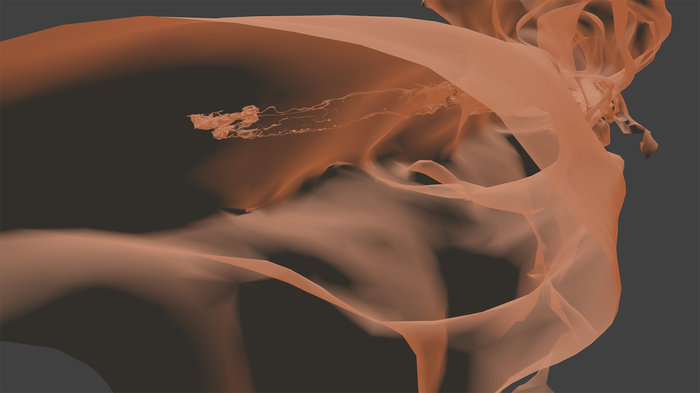
For some time, scientists have known that the Moon and Mars have some fascinating similarities to Earth. In addition to being similar in composition, there is ample evidence that both bodies had active geological pasts. This includes stable lava tubes which are very similar to those that exist here on Earth. And in the future, these tubes could be an ideal location for outposts and colonies.
However, before we can begin choosing where to settle, these locations need to be mapped out to determining which would be suitable for human habitation. Luckily, a team of speleologists (cave specialists), geologists and ESA astronauts recently created the largest 3D image of a lava tube ever created. As part of the ESA’s PANGAEA program, this technology could one day help scientists map out cave systems on the Moon and Mars.
The lava tube in question was the La Cueva de Los Verdes, a famous tourist destination in Lanzarote, Spain. In addition to ESA astronaut Matthias Mauer, the team consisted of Tommaso Santagata (a speleologist from the University of Padova and the co-founder of the Virtual Geographic Agency), Umberto Del Vecchio and Marta Lazzaroni – a geologists and a masters student from the University of Padova, respectively.
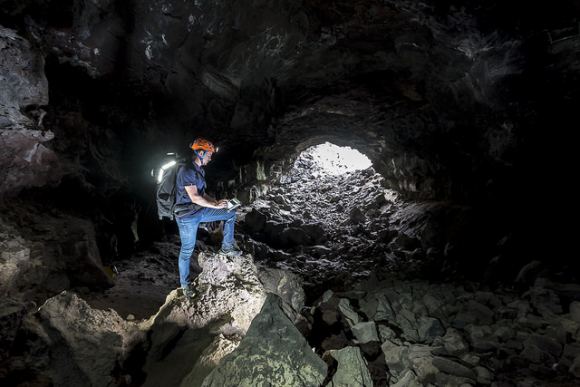
Last year, the team mapped the path of this cave system as part of the ESA’s 2017 Pangaea-X campaign. As one of many ESA Spaceflight Analog field campaigns, the purpose of Pangaea-X is to conduct experiments designed to improve the future of the ESA’s Planetary ANalogue Geological and Astrobiological Exercise for Astronauts (PANGAEA) training course.
For five days in November 2017, this campaign mobilized 50 people, four space agencies and 18 organizations in five different locations. The La Cueva de los Verdes lava tube was of particular importance since it is one of the world’s largest volcanic cave complexes, measuring roughly 8 km in length. Some of these caves are even large enough to accommodate residential streets and houses.
During the campaign, Mauer, Santagata, Vecchio and Lazzaroni relied on two instruments to map the lava tube in detail. These included the Pegasus Backpack, a wearable mapping solution that collects geometric data without a satellite ad synchronizes images collected by five cameras and two 3D imaging laser profilers, and the Leica BLK360 – the smallest and lightest imaging scanner on the market.
Join us on a trip through a volcanic wormhole! This 3D scan of the 8-km 'La Cueva de los Verdes' lava tube in Lanzarote, #Spain, was acquired during the @ESA_CAVES #Pangaea campaign.
Details: https://t.co/5csZlbzv4p pic.twitter.com/bVeZFCeyIP— European Space Agency (@esa) March 13, 2018
In less than three hours, the team managed to map all the contours of the lava tube. And while the results of the campaign continue to be analyzed, the team chose to use the data they obtained to produce a 3D visual of all the twists and turns of the lava tube. The scan that resulted covers a 1.3 km section of the cave system with an unprecedented resolution of a few centimeters.
Santagata and the Virtual Geography Agency also turned their 3D visual into a lovely video titled “Lave tube fly-through”, which beautifully illustrates the winding and organic nature of the lava tube system. This video was posted to the ESA’s twitter feed on Tuesday, March 13th (shown above). This video, like the scans that preceded it, represent a breakthrough in geological mapping and astronaut training.
While lava tubes have been mapped since the 1970s, a clear view of this subterranean passage has remained elusive until now. Beyond being the first, the scans the team conducted could also help scientists to study the origins of the cave system, its peculiar formations, and assist local institutions in protecting the subterranean environment. As intended, the scans could also assist future space exploration and colonization efforts.
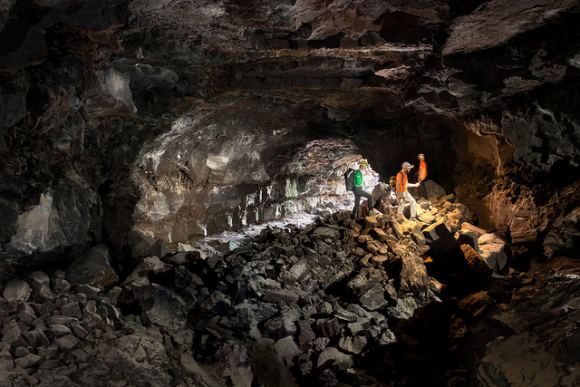
For instance, the 8 km lava tube has both dry and water-filled sections. In the six-kilometer dry section, the lava tube has natural openings (jameos), that are aligned along the top of the cave pathway. These formations are very similar to “skylights” that have been observed on the Moon and Mars, which are holes in the surface that open into stable lava tubes.
Such structures are considered to be a good place for building outposts and colonies since they are naturally shielded from radiation and micrometeorites. Lava tubes also have a constant temperature, therefore offering protection against environmental extremes, and could provide access to underground sources of water ice. Some sections could also be sealed off and pressurized to create a colony.
As such, exploring such environments here on Earth is a good way to train astronauts to explore them on other bodies. As all astronauts know, mapping an environment is the first step in exploration, especially when you are looking for a place to establish a base camp. And in time, this information can be used to establish more permanent settlements, giving rise to eventual colonization.
How Do We Settle on Mercury?
Welcome back to the first in our series on Settling the Solar System! First up, we take a look at that hot, hellish place located closest to the Sun – the planet Mercury!
Humanity has long dreamed of establishing itself on other worlds, even before we started going into space. We’ve talked about colonizing the Moon, Mars, and even establishing ourselves on exoplanets in distant star systems. But what about the other planets in our own backyard? When it comes to the Solar System, there is a lot of potential real estate out there that we don’t really consider.
Well, consider Mercury. While most people wouldn’t suspect it, the closest planet to our Sun is actually a potential candidate for settlement. Whereas it experiences extremes in temperature – gravitating between heat that could instantly cook a human being to cold that could flash-freeze flesh in seconds – it actually has potential as a starter colony.
Examples in Fiction:
The idea of colonizing Mercury has been explored by science fiction writers for almost a century. However, it has only been since the mid-20th century that colonization has been dealt with in a scientific fashion. Some of the earliest known examples of this include the short stories of Leigh Brackett and Isaac Asimov during the 1940s and 50s.
In the former’s work, Mercury is a tidally-locked planet (which was what astronomers believed at the time) that has a “Twilight Belt” characterized by extremes in heat, cold, and solar storms. Some of Asimov’s early work included short stories where a similarly tidally-locked Mercury was the setting, or characters came from a colony located on the planet.

These included “Runaround” (written in 1942, and later included in I, Robot), which centers on a robot that is specifically designed to cope with the intense radiation of Mercury. In Asimov’s murder-mystery story “The Dying Night” (1956) – in which the three suspects hail from Mercury, the Moon, and Ceres – the conditions of each location are key to finding out who the murderer is.
In 1946, Ray Bradbury published “Frost and Fire”, a short story that takes place on a planet described as being next to the sun. The conditions on this world allude to Mercury, where the days are extremely hot, the nights extremely cold, and humans live for only eight days. Arthur C. Clarke’s Islands in the Sky (1952) contains a description of a creature that lives on what was believed at the time to be Mercury’s permanently dark side and occasionally visits the twilight region.
In his later novel, Rendezvous with Rama (1973), Clarke describes a colonized Solar System which includes the Hermians, a toughened branch of humanity that lives on Mercury and thrives off the export of metals and energy. The same setting and planetary identities are used in his 1976 novel Imperial Earth.
In Kurt Vonnegut’s novel The Sirens of Titan (1959), a section of the story is set in caves located on the dark side of the planet. Larry Niven’s short story “The Coldest Place” (1964) teases the reader by presenting a world that is said to be the coldest location in the Solar System, only to reveal that it is the dark side of Mercury (and not Pluto, as is generally assumed).
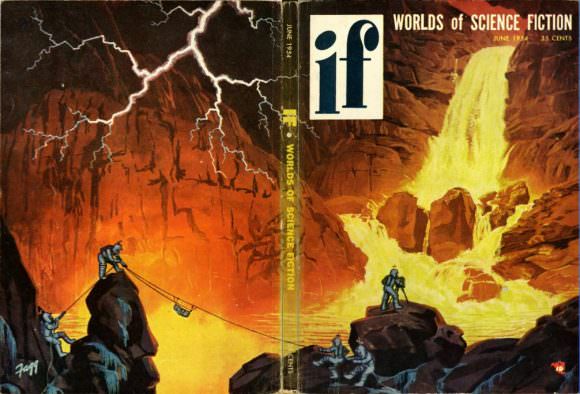
Mercury also serves as a location in many of Kim Stanley Robinson’s novels and short stories. These include The Memory of Whiteness (1985), Blue Mars (1996), and 2312 (2012), in which Mercury is the home to a vast city called Terminator. To avoid the harmful radiation and heat, the city rolls around the planet’s equator on tracks, keeping pace with the planet’s rotation so that it stays ahead of the Sun.
In 2005, Ben Bova published Mercury (part of his Grand Tour series) that deals with the exploration of Mercury and colonizing it for the sake of harnessing solar energy. Charles Stross’ 2008 novel Saturn’s Children involves a similar concept to Robinson’s 2312, where a city called Terminator traverses the surface on rails, keeping pace with the planet’s rotation.
Proposed Methods:
A number of possibilities exist for a colony on Mercury, owing to the nature of its rotation, orbit, composition, and geological history. For example, Mercury’s slow rotational period means that one side of the planet is facing towards the Sun for extended periods of time – reaching temperatures highs of up to 427 °C (800 °F) – while the side facing away experiences extreme cold (-193 °C; -315 °F).
In addition, the planet’s rapid orbital period of 88 days, combined with its sidereal rotation period of 58.6 days, means that it takes roughly 176 Earth days for the Sun to return to the same place in the sky (i.e. a solar day). Essentially, this means that a single day on Mercury lasts as long as two of its years. So if a city were placed on the night-side, and had tracks wheels so it could keep moving to stay ahead of the Sun, people could live without fear of burning up.
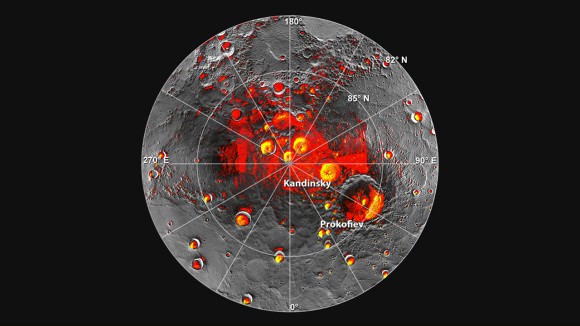
In addition, Mercury’s very low axial tilt (0.034°) means that its polar regions are permanently shaded and cold enough to contain water ice. In the northern region, a number of craters were observed by NASA’s MESSENGER probe in 2012 which confirmed the existence of water ice and organic molecules. Scientists believe that Mercury’s southern pole may also have ice, and claim that an estimated 100 billion to 1 trillion tons of water ice could exist at both poles, which could be up to 20 meters thick in places.
In these regions, a colony could be built using a process called “paraterraforming” – a concept invented by British mathematician Richard Taylor in 1992. In a paper titled “Paraterraforming – The Worldhouse Concept”, Taylor described how a pressurized enclosure could be placed over the usable area of a planet to create a self-contained atmosphere. Over time, the ecology inside this dome could be altered to meet human needs.
In the case of Mercury, this would include pumping in a breathable atmosphere, and then melting the ice to create water vapor and natural irrigation. Eventually, the region inside the dome would become a livable habitat, complete with its own water cycle and carbon cycle. Alternately, the water could be evaporated, and oxygen gas created by subjecting it to solar radiation (a process known as photolysis).
Another possibility would be to build underground. For years, NASA has been toying with the idea of building colonies in stable, underground lava tubes that are known to exist on the Moon. And geological data obtained by the MESSENGER probe during flybys it conducted between 2008 and 2012 led to speculation that stable lava tubes might exist on Mercury as well.
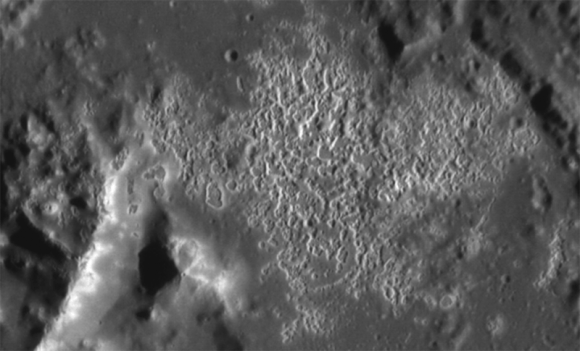
This includes information obtained during the probe’s 2009 flyby of Mercury, which revealed that the planet was a lot more geologically active in the past than previously thought. In addition, MESSENGER began spotting strange Swiss cheese-like features on the surface in 2011. These holes, which are known as “hollows”, could be an indication that underground tubes exist on Mercury as well.
Colonies built inside stable lava tubes would be naturally shielded to cosmic and solar radiation, extremes in temperature, and could be pressurized to create breathable atmospheres. In addition, at this depth, Mercury experiences far less in the way of temperature variations and would be warm enough to be habitable.
Potential Benefits:
At a glance, Mercury looks similar to the Earth’s Moon, so settling it would rely on many of the same strategies for establishing a moon base. It also has abundant minerals to offer, which could help move humanity towards a post-scarcity economy. Like Earth, it is a terrestrial planet, which means it is made up of silicate rocks and metals that are differentiated between an iron core and silicate crust and mantle.
However, Mercury is composed of 70% metals whereas’ Earth’s composition is 40% metal. What’s more, Mercury has a particular large core of iron and nickel, and which accounts for 42% of its volume. By comparison, Earth’s core accounts for only 17% of its volume. As a result, if Mercury were to be mined, enough minerals could be produced to last humanity indefinitely.
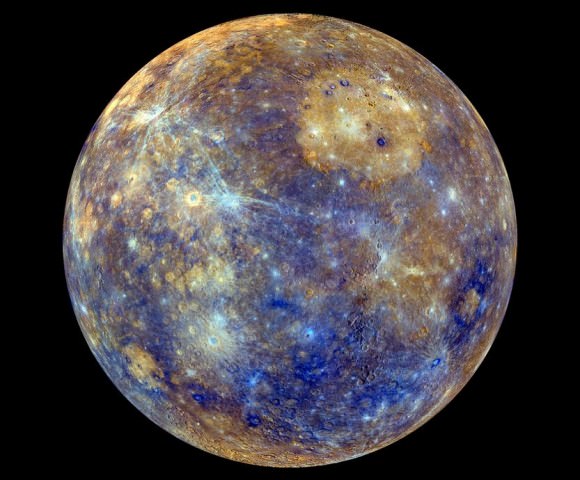
Its proximity to the Sun also means that it could harness a tremendous amount of energy. This could be gathered by orbital solar arrays, which would be able to harness energy constantly and beam it to the surface. This energy could then be beamed to other planets in the Solar System using a series of transfer stations positioned at Lagrange Points.
Also, there’s the matter of Mercury’s gravity, which is 38% percent of Earth’s gravity. This is over twice what the Moon experiences, which means colonists would have an easier time adjusting to it. At the same time, it is also low enough to present benefits as far as exporting minerals is concerned, since ships departing from the surface would need less energy to achieve escape velocity.
Lastly, there is the distance to Mercury itself. At an average distance of about 93 million km (58 million mi), Mercury ranges between being 77.3 million km (48 million mi) to 222 million km (138 million mi) away from the Earth. This puts it a lot closer than other possible resource-rich areas like the Asteroid Belt (329 – 478 million km distant), Jupiter and its system of moons (628.7 – 928 million km), or Saturn’s (1.2 – 1.67 billion km).
Also, Mercury achieves inferior conjunction – the point where it is at its closest point to Earth – every 116 days, which is significantly shorter than either Venus’ or Mars’. Basically, missions destined for Mercury could launch almost every four months, whereas launch windows to Venus and Mars would have to take place every 1.6 years and 26 months, respectively.
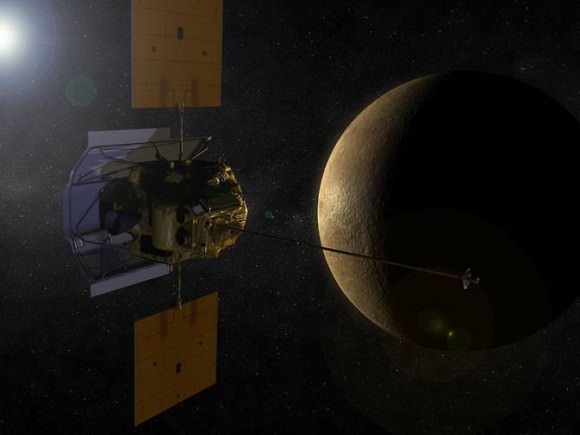
In terms of travel time, several missions have been mounted to Mercury that can give us a ballpark estimate of how long it might take. For instance, the first spacecraft to travel to Mercury, NASA’s Mariner 10 spacecraft (which launched in 1973), took about 147 days to get there.
More recently, NASA’s MESSENGER spacecraft launched on August 3rd, 2004 to study Mercury in orbit, and made its first flyby on January 14th, 2008. That’s a total of 1,260 days to get from Earth to Mercury. The extended travel time was due to engineers seeking to place the probe in orbit around the planet, so it needed to proceed at a slower velocity.
Challenges:
Of course, a colony on Mercury would still be a huge challenge, both economically and technologically. The cost of establishing a colony anywhere on the planet would be tremendous and would require abundant materials to be shipped from Earth, or mined on site. Either way, such an operation would require a large fleet of spaceships capable of making the journey in a respectable amount of time.
Such a fleet does not yet exist, and the cost of developing it (and the associated infrastructure for getting all the necessary resources and supplies to Mercury) would be tremendous. Relying on robots and in-situ resource utilization (ISRU) would certainly cut costs and reduce the amount of materials that would need to be shipped. But these robots and their operations would need to be shielded from radiation and solar flares until they got the job done.
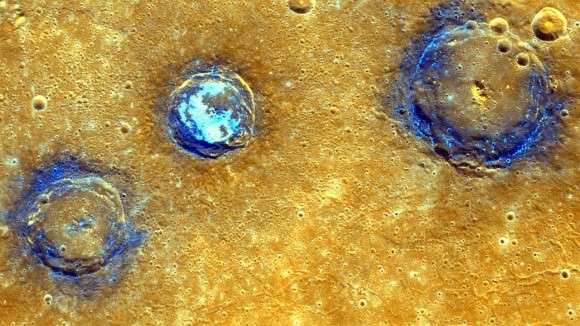
Basically, the situation is like trying to establish a shelter in the middle of a thunderstorm. Once it is complete, you can take shelter. But in the meantime, you’re likely to get wet and dirty! And even once the colony was complete, the colonists themselves would have to deal with the ever-present hazards of radiation exposure, decompression, and extremes in heat and cold.
As such, if a colony was established on Mercury, it would be heavily dependent on its technology (which would have to be rather advanced). Also, until such time as the colony became self-sufficient, those living there would be dependent on supply shipments that would have to come regularly from Earth (again, shipping costs!)
Still, once the necessary technology was developed, and we could figure out a cost-effective way to create one or more settlements and ship to Mercury, we could look forward to having a colony that could provide us with limitless energy and minerals. And we would have a group of human neighbors known as Hermians!
As with everything else pertaining to colonization and terraforming, once we’ve established that it is in fact possible, the only remaining question is “how much are we willing to spend?”
We have written many interesting articles on colonization here at Universe Today. Here’s Why Colonize the Moon First?, Colonizing Venus with Floating Cities, Will We Ever Colonize Mars?, and The Definitive Guide to Terraforming.
Astronomy Cast also has some interesting episodes on the subject. Check out Episode 95: Humans to Mars, Part 2 – Colonists, Episode 115: The Moon, Part 3 – Return to the Moon, Episode 381: Hollowing Asteroids in Science Fiction.
Sources:
- Taylor, Richard L. S. (1992) Paraterraforming – The worldhouse concept. Journal of the British Interplanetary Society, vol. 45, no. 8
- Viorel Badescu, Kris Zacny (eds). Inner Solar System: Prospective Energy and Material Resources. Springer, 2015
- NASA – Strange Hollows Discovered on Mercury
- NASA – Biggest, Deepest Crater Exposes Hidden, Ancient Moon
- NASA – What is the Planet Mercury?
- NASA Science – Mercury by the Numbers
There Could Be Lava Tubes on the Moon, Large Enough for Whole Cities
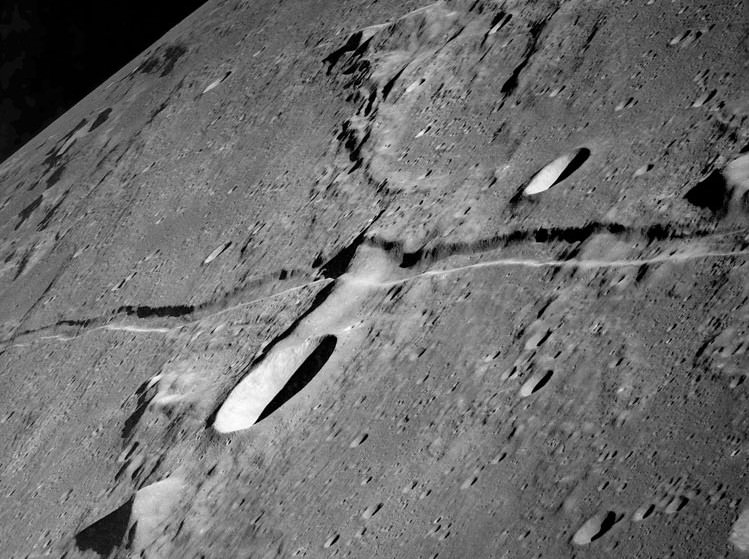
Every year since 1970, astronomers, geologists, geophysicists, and a host of other specialists have come together to participate in the Lunar and Planetary Science Conference (LPCS). Jointly sponsored by the Lunar and Planetary Institute (LPI) and NASA’s Johnson Space Center (JSC), this annual event is a chance for scientists from all around the world to share and present the latest planetary research concerning Earth’s only moon.
This year, one of the biggest attention-grabbers was the findings presented on Tuesday, March 17th by a team of students from Purdue University. Led by a graduate student from the university’s Department of Earth, Atmospheric and Planetary Sciences, the study they shared indicates that there may be stable lava tubes on the moon, ones large enough to house entire cities.
In addition to being a target for future geological and geophysical studies, the existence of these tubes could also be a boon for future human space exploration. Basically, they argued, such large, stable underground tunnels could provide a home for human settlements, shielding them from harmful cosmic radiation and extremes in temperature.
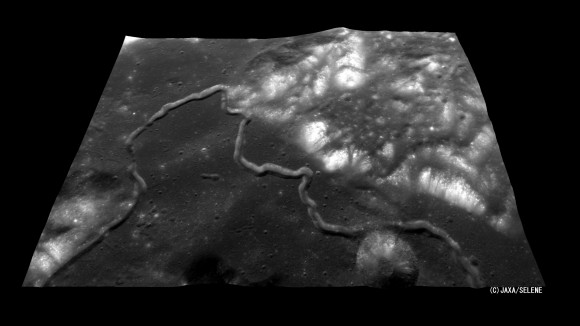
Lava tubes are natural conduits formed by flowing lava that is moving beneath the surface as a result of a volcanic eruption. As the lava moves, the outer edges of it cools, forming a hardened, channel-like crust which is left behind once the lava flow stops. For some time, Lunar scientists have been speculating as to whether or not lava flows happen on the Moon, as evidenced by the presence of sinuous rilles on the surface.
Sinuous rilles are narrow depressions in the lunar surface that resemble channels, and have a curved paths that meanders across the landscape like a river valley. It is currently believed that these rilles are the remains of collapsed lava tubes or extinct lava flows, which is backed up by the fact they usually begin at the site of an extinct volcano.
Those that have been observed on the Moon in the past range in size of up to 10 kilometers in width and hundreds of kilometers in length. At that size, the existence of a stable tube – i.e. one which had not collapsed to form a sinuous rille – would be large enough to accommodate a major city.
For the sake of their study, the Purdue team explored whether lava tubes of the same scale could exist underground. What they found was that the stability of a lava tube depended on a number of variables- including width, roof thickness and the stress state of the cooled lava. he researchers also modeled lava tubes with walls created by lava placed in one thick layer and with lava placed in many thin layers.

David Blair, a graduate student in Purdue’s Department of Earth, Atmospheric and Planetary Sciences, led the study that examined whether empty lava tubes more than 1 kilometer wide could remain structurally stable on the moon.
“Our work is somewhat unique in that we’ve combined the talents of people from various Departments at Purdue,” Blair told Universe Today via email. “With guidance from Prof. Bobet (a civil engineering professor) we’ve been able to incorporate a modern understanding of rock mechanics into our computer models of lava tubes to see how they might actually fail and break under lunar gravity.”
For the sake of their research, the team constructed a number of models of lava tubes of different sizes and with different roof thicknesses to test for stability. This consisted of them checking each model to see if it predicted failure anywhere in the lava tube’s roof.
“What we found was surprising,” Blair continued, “in that much larger lava tubes are theoretically possible than what was previously thought. Even with a roof only a few meters thick, lava tubes a kilometer wide may be able to stay standing. The reason why, though, is a little less surprising. The last work we could find on the subject is from the Apollo era, and used a much simpler approximation of lava tube shape – a flat beam for a roof.
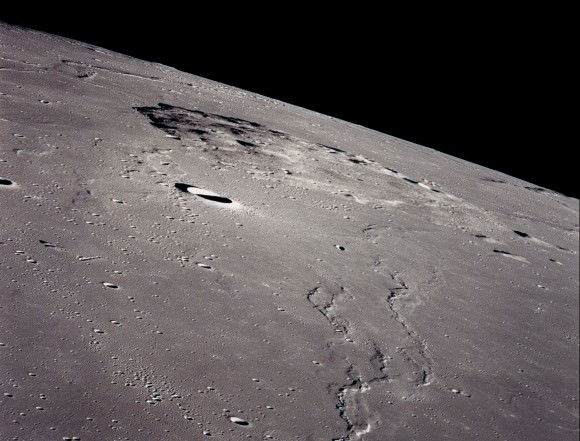
The study he refers to, “On the origin of lunar sinuous rilles“, was published in 1969 in the journal Modern Geology. In it, professors Greeley, Oberbeck and Quaide advanced the argument that sinuous rilles formation was tied to the collapse of lava flow tubes, and that stable ones might still exist. Calculating for a flat-beam roof, their work found a maximum lava tube size of just under 400 m.
“Our models use a geometry more similar to what’s seen in lava tubes on Earth,” Blair said, “a sort of half-elliptical shape with an arched roof. The fact that an arched roof lets a larger lava tube stay standing makes sense: humans have known since antiquity that arched roofs allow tunnels or bridges to stay standing with wider spans.”
The Purdue study also builds on previous studies conducted by JAXA and NASA where images of “skylights” on the Moon – i.e. holes in the lunar surface – confirmed the presence of caverns at least a few tens of meters across. The data from NASA’s lunar Gravity Recovery And Interior Laboratory (GRAIL) – which showed big variations in the thickness of the Moon’s crust is still being interpreted, but could also be an indication of large subsurface recesses.
As a result, Blair is confident that their work opens up new and feasible explanations for many different types of observations that have been made before. Previously, it was unfathomable that large, stable caverns could exist on the Moon. But thanks to his team’s theoretical study, it is now known that under the proper conditions, it is least possible.
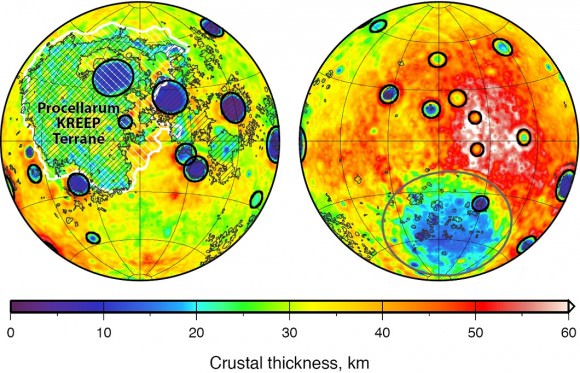
Another exciting aspect that this work is the implications it offers for future exploration and even colonization on the Moon. Already, the issue of protection against radiation is a big one. Given that the Moon has no atmosphere, colonists and agricultural operations will have no natural shielding from cosmic rays.
“Geologically stable lava tubes would absolutely be a boon to human space exploration,” Blair commented. “A cavern like that could be a really ideal place for building a lunar base, and generally for supporting a sustained human presence on the Moon. By going below the surface even a few meters, you suddenly mitigate a lot of the problems with trying to inhabit the lunar surface.”
Basically, in addition to protecting against radiation, a subsurface base would sidestep the problems of micrometeorites and the extreme changes in temperature that are common on the lunar surface. What’s more, stable, subsurface lava tubes could also make the task of pressurizing a base for human habitation easier.
“People have studied and talked about all of these things before,” Blair added, “but our work shows that those kinds of opportunities could potentially exist – now we just have to find them. Humans have been living in caves since the beginning, and it might make sense on the Moon, too!”
In addition to Melosh, Blair and Bobet, team members include Loic Chappaz and Rohan Sood, graduate students in the School of Aeronautics and Astronautics; Kathleen Howell, Purdue’s Hsu Lo Professor of Aeronautical and Astronautical Engineering; Andy M. Freed, an associate professor of earth, atmospheric and planetary sciences; and Colleen Milbury, a postdoctoral research associate in the Department of Earth, Atmospheric and Planetary Sciences.
Further Reading: Purdue News
What Are These Hollows on Mercury?
Emily Lakdawalla from the planetary society describes one of the mysteries that’s currently fascinating her. There are strange structures on Mercury which have been called “hollows”. What might they be?
Continue reading “What Are These Hollows on Mercury?”
LRO Takes Closer Look at Moon Caves
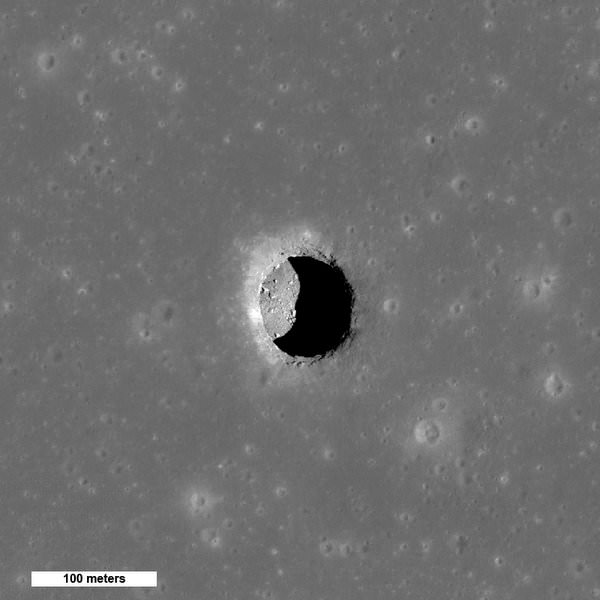
As promised, the Lunar Reconnaissance Orbiter is taking more detailed looks at the lunar pits, or lava tubes that have been discovered by LRO and the Kaguya spacecraft. These are deep holes on the moon that could open into vast underground tunnels, and could serve as a safe, radiation shielding habitats for future human lunar explorers. Plus, they are just plain intriguing! This image of a pit found in the Sea of Tranquility (Mare Tranquillitatis) was taken as the Sun was almost straight overhead, illuminating the region. By comparing this image with previous images that have different lighting, scientists can estimate the depth of the pit. They believe it to be over 100 meters!
See more “in-depth” look at more of the caves on the Moon, below:

These two images show a pit in Mare Ingenii, which reveal different portions of the floor as the Sun crosses from west to east. Again, by measuring the shadows in different lighting, the Sea of Cleverness pit appears to be about 70 meters deep and about 120 meters wide.
These long, winding lava tubes are like structures we have on Earth. They are created when the top of a stream of molten rock solidifies and the lava inside drains away, leaving a hollow tube of rock. There have been hints that the Moon had lava tubes based on observations of long, winding depressions carved into the lunar surface by the flow of lava, called sinuous rilles.
If a human geologist could ever climb down inside these tubes on the Moon, we could learn so much about the Moon’s history, and sort of travel back in time by studying the different layers on the Moon, just like we do on Earth.

LROC has now imaged the Marius Hills pit three times, each time with very different lighting. The center view has an incidence angle of 25° that illuminates about three-quarters of the floor. The Marius pit is about 34 meters deep and 65 by 90 meters wide.
Read more about the Ingenii, Tranquillitatis, and Marius pits at the LROC website, and you can search the nearby area for clues in the full LROC NAC frame that may help determine if an extended lava tube system still exists beneath the surface.
Source: LROC website

